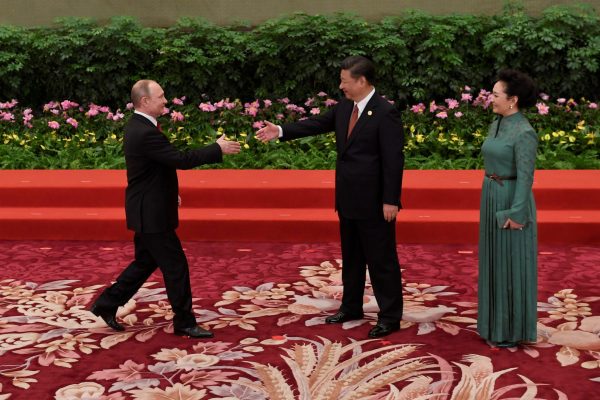The EEU was officially launched on 1 January 2015 with the medium-term goal of realising the free flow of goods, services, capital and labour between member countries by 2025, and, ultimately, becoming a union like the EU.
Proposed by Chinese President Xi Jinping in 2013, the BRI aims to build a prosperous Silk Road Economic Belt and 21st-century Maritime Silk Road. This initiative now includes 65 countries that altogether make up 62 per cent of global population, 40 per cent of global land area and 31 per cent of aggregate GDP.
The ‘5 + 1’ initiative is key to the success of the BRI for three key reasons.
First is the unique position of EEU countries geographically. The EEU sits within the hinterland of the Eurasian landmass, which acts as a hub connecting East Asian and European trade and transportation. Thus, construction of the Silk Road Economic Belt requires China to work with Russia and Central and West Asian countries. The five countries of the EEU are therefore pivotal to extending the Silk Road Economic Belt westward and northward.
The BRI comprises six economic corridors, three of which link directly to EEU member countries: the China–Mongolia–Russia Economic Corridor; the New Eurasian Land Bridge Economic Corridor, which passes through Kazakhstan and Russia; and the China–Central Asia–West Asia Economic Corridor, which stretches from the autonomous region of Xinjiang through Kazakhstan and Kyrgyzstan. These three economic corridors are fundamental to the promotion and successful implementation of the BRI.
Second, the EEU countries boast significant natural resource endowments. According to 2015 World Bank data, the BRI countries (excluding China) comprised 40.5 million square kilometres of land area, of which the EEU countries make up 48 per cent of the total. BRI countries’ total GDP in 2015 was roughly US$12 trillion, to which EEU members contributed US$1.7 trillion. But the EEU members’ proportion of total population was only 5.6 per cent. In other words, with less than 6 per cent of the total population, the EEU accounted for nearly 15 per cent of GDP of the BRI countries (excluding China).
EEU countries are also rich in water resources. Specifically, EEU countries held 36 per cent of BRI member countries’ total water resources in 2014. And data from the 2015 World Energy Statistics Yearbook suggest that the production of the five EEU countries was 28.93 per cent of the total energy output from fossil fuels in the BRI member countries.
With EEU countries boasting rich endowments of resources, and China home to a huge domestic market and capital supplies, there is massive potential for cooperation under the BRI framework.
Third, Sino-Russian bilateral relations are key to the implementation of the BRI and can be further strengthened within the ‘5+ 1’ framework. Already, both countries have stressed the importance of their cooperation. For instance, the two countries signed a joint declaration on 8 May 2015 to integrate the construction of the EEU and the Silk Road Economic Belt. The Sino-Russian partnership should be open and transparent, while focusing on the interests of both sides, and should accept the gradual participation of member countries of the EEU, ASEAN and the Shanghai Cooperation Organisation.
In general, ‘5 + 1’ cooperation also contributes to interregional economic and trade cooperation. In the context of globalisation, countries around the world are largely deepening economic ties and social connectivity. Regional economic integration provides effective institutional infrastructure to improve the region’s competitiveness. China has worked to establish close relations with all EEU members, and economic and trade cooperation will be among the most important areas to further these relationships.
There are a number of key policy coordination measures that can be taken to further strengthen ‘5 + 1’ cooperation and promote China’s BRI.
In terms of funding, Chinese financial institutions should provide more support to the five EEU countries — particularly by encouraging qualified Chinese private companies to open financial businesses in those countries. Furthermore, relying solely on Chinese state funding for the BRI will not be enough. The ‘5 + 1’ countries need to start directing their large volumes of private capital, which are currently looking for investment opportunities, into special funds for the BRI.
Another avenue for deepening cooperation is through investment policy coordination. EEU countries, particularly Kazakhstan, have interests in establishing closer investment partnerships with China. The Kazakh and Chinese governments have had some good communication relating to investment policy coordination — for example, the two countries signing an agreement on investment cooperation for 2016–22 — but there is still room to expand cooperation in this area.
‘5 + 1’ relations can also be deepened through enhancing trade policy coordination. China and Russia have already signed an agreement to promote ‘5 + 1’ cooperation at the highest levels of leadership. This should be followed up by the formation of a ‘5 + 1’ free-trade agreement, which would be good not only for promoting the BRI, but also to drive trade prosperity and economic growth for EEU countries.
Finally, the ‘5 + 1’ countries could also increase industrial policy coordination. EEU countries have industrial advantages in agriculture, energy and minerals, but the manufacturing industry is underdeveloped and industrialisation is lagging. Further coordination of industrial policy would directly contribute to the promotion of complementary development between China and these countries in relevant industries, to promote regional economic prosperity.
Biliang Hu is Professor of Economics and Dean of the Emerging Markets Institute, Beijing Normal University. Qingjie Liu is a Postdoctoral Researcher at the Emerging Markets Institute, Beijing Normal University and Jiao Yan is a postdoctoral candidate at the School of Economics and Resource Management, Beijing Normal University.
This article is a digest of the authors’ chapter from the publication for the latest China Update. A free e-book is available here.

